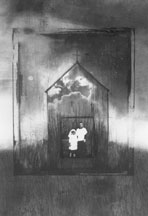Limits Of the Unbound
Robin McCloskey's photographs stand out from the pack at 'Unbound and Exposed' show
By Ann Elliott Sherman
JUDGING FROM Unbound and Exposed at WORKS/San Jose, "alternative photographic processes" has come to mean about as much as "alternative music." Far from corralling raw, unleashed explorations of photographic possibility, the show is, with a few exceptions, a tidy gathering of banal and derivative work tarted up a bit to appear more exotic.
Rather than taking potshots, a few observations. Hand coloring is this show's macarena--seems like everywhere you look, someone's doing it, and with wildly divergent degrees of aptitude and subtlety. As with any resurrected, essentially nostalgic technique, a little goes a long way.
Second, the ghost of Robert Mapplethorpe hovers noticeably over several artists' work. Which is not to announce the discovery of an heir apparent. Minus the electrical charge that arced from zeniths of aesthetic purity to perigees of avid obsession in Mapplethorpe's photographs, these bleached reprisals make one long for any sign of immoderate desire and urgency.
In a somber, sadder-but-wiser vein, Robin McCloskey delivers the goods. In a series that stretches the definition of a photographic work to incorporate various combinations of photo-etching, etching, monotype, hand coloring and collage, McCloskey creates a sense of personal, internal experience nearly swallowed by a harsh and indifferent world.
The tiny photographed images are always framed by a crude outline of a house of one sort or another--more the idea of a shelter than its effective realization. These open-walled homes are completely engulfed by an immense, uninterrupted landscape, a wild prairie or swelling ocean stretched beneath an expanse of sky whitewashed by the glare of an unseen sun or darkening with storm clouds. Whatever is harbored within history on a personal, domestic scale is dwarfed by the big picture, rendered insignificant.
Unlike some of the show's other participants, McCloskey does not romanticize nature or focus upon making a pretty picture. This is a hard-won beauty only the hungriest of eye can discern. The fields are dry and brown, the sea glaucous or steely, and there's not a blue sky or fluffy cloud in sight. It's a pioneer's take on what's out there--wilderness as a force to be reckoned with.
Drawn in by the white-gold light at the horizon, we submit to the rigors of McCloskey's unforgiving universe, and an interesting inversion of our initial view occurs. Hope and charity, those homely symbols of faith, become the center of that universe, quietly heroic stands against surrender. Look longer, and another interpretation is equally valid: the domestic acts as a stricture, a boundary attempting to draw a line between us and the rest of the natural world. Look again, and those elongated structures suggest coffins or headstones, the photographs memorials.
In their embrace of a fluxing, multiple truth and their tacit acknowledgment of a fundamental lack of dominion over nature, McCloskey's chronicles of overlapping personal, emotional and historical realities turn the landscape genre inside out. You might say they radically feminize it.
THOUGH DECIDEDLY more lightweight, there are some other interesting pieces worthy of mention. Sharin Smelser's photoquilts pieced together in traditional quilting patterns are beautifully crafted, although the prosaic images employed sometimes detract from the overall impact. Where they're spliced in to emphasize form and color, as in the Salisbury Cathedral Lone Star, the marriage of disciplines works better.
Amish Bricks is the most successful of Smelser's quilts, captivating from a distance and holding up to close scrutiny. A single, arresting underwater view of a swimmer catching his breath is repeated in rectangular pieces printed in the darkly vivid secondary shades characteristic of Amish art. The colors are deftly manipulated in subtle gradations that move diagonally across the quilt's center. These are framed by a dark band of blue-black edged in brick red, which turn out to be fashioned from photographed cloth. A tour de force, Amish Bricks transcends its gimmick.
17 Views of Parhelion is Ruth Eckland and Marta Thoma's diverting departure from the flat photograph that literally takes things into another dimension. A billowing orb of wire mesh with a decidedly vaginal opening lights up with images from a slide projector. Fiery colors, helical loops and ice-blue ribs seem to float in the darkened room, to the musical accompaniment of Gwen Jones' songs for aboriginal horn.
The unintentional bonus, constellations of holes previously punched through the gallery's galvanized metal walls, underscores (and nearly upstages) the sunspot theme. Not content merely to subvert the typical photographic format, Eckland and Thoma also play with the whole notion of the photograph as a window on the world. Would that their less imaginative compadres had loosened up half as much.
[ Metro | Metroactive Central | Archives ]
This page was designed and created by the Boulevards team.

House of Memories: A detail from Robin McCloskey's "First Communion" demonstrates the photographer's use of a variety of techniques, including etching and aquatint, in a single piece.
Unbound and Exposed runs through Oct. 4 at WORKS/San Jose, 260 Jackson St. (408/295-8378)
From the September 19-25, 1996 issue of Metro
![[Metroactive Arts]](/arts/gifs/art.gif)